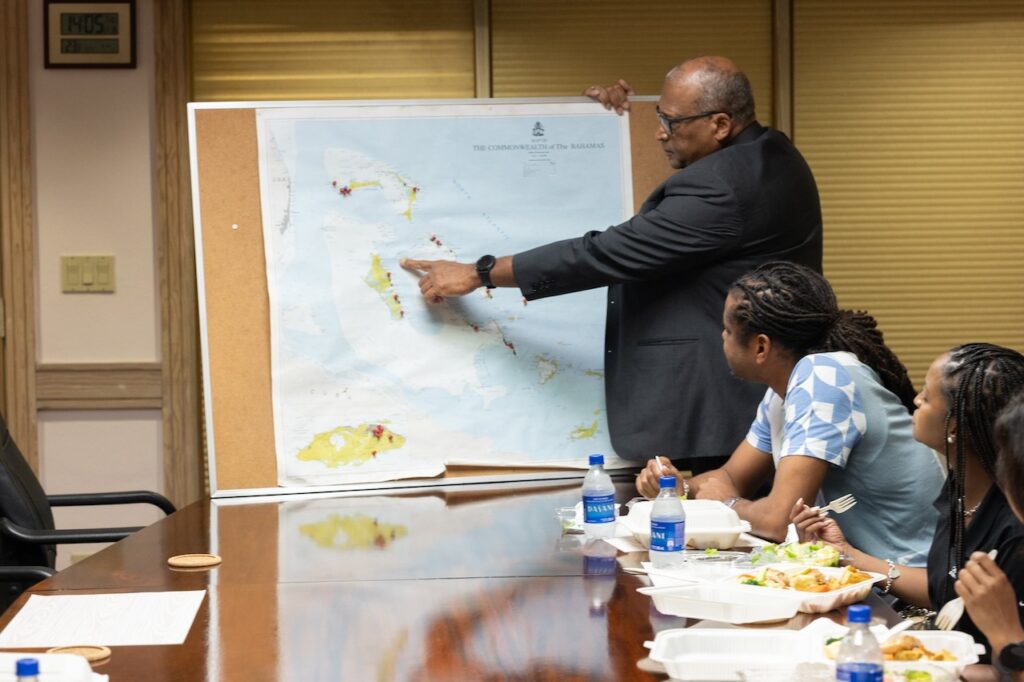TREASURE CAY, Abaco, Bahamas (OSV News) — The parishioners of this Hurricane Dorian-ravaged island due east of South Florida are once again celebrating the Christmas season in their church — thanks in part to Florida Catholics.
Archbishop Patrick C. Pinder of Nassau met in November with a delegation from Catholic Charities of the Archdiocese of Miami, both at his offices and in Abaco, to discuss recovery progress following the Category 5 hurricane. The delegation included journalists from the Florida Catholic and Radio Paz, the archdiocesan station.
Hurricane Dorian struck the Bahamas in early September 2019, just months before the global coronavirus pandemic would complicate rebuilding efforts. It has been characterized as the worst cyclone to ever strike the islands.
Msgr. Roberto Garza, board chairman for Catholic Charities of Miami, and Charities CEO Peter Routsis-Arroyo, have made several fact-finding visits to the Bahamas since 2019 to help assess human needs and material damages suffered in the Nassau archdiocese.
In South Florida, provisions, supplies and financial resources poured in following Dorian, including a series of shipments made possible by the Archdiocese of Miami’s special collection for the Bahamas. All told, the archdiocese contributed approximately $1.5 million to the recovery efforts, according to Routsis-Arroyo.
“Thankfully a lot has been rebuilt since the last time you were here, but you can still see a lot of marks of what Dorian did,” especially in central Abaco, Archbishop Pinder told his guests. Central Abaco is situated due east of West Palm Beach, which was spared damages after Dorian’s track took a hard turn northward.
The National Oceanic and Atmospheric Administration has estimated Hurricane Dorian’s total damages in the Bahamas at $3.4 billion. The United Nations Office for the Coordination of Humanitarian Affairs reported a death toll of 74 in the Bahamas, with at least 282 people unaccounted for. The Inter-American Development Bank said the hurricane left 29,500 people homeless or jobless, with Abaco suffering 87% of the damage, and more than 75% of all homes on the island damaged.
After arriving in Nassau for a briefing on the four years of recovery efforts since Dorian, the Miami delegation accompanied Archbishop Pinder to Treasure Cay, Abaco, to tour and celebrate Mass at the newly rebuilt and dedicated Sts. Mary and Andrew Catholic Church.
The old church was destroyed during Dorian, whose most punishing flood waters and winds struck this area and the north of Grand Bahama island, causing the temporary dislocation of many residents as well as Catholic school students who were placed elsewhere following the hurricane. Most fled to New Providence.
“Outside of Nassau in New Providence, Grand Bahamas and Abaco are the main population centers, so you had significant disruption of life,” Archbishop Pinder said. “Our schools there closed, and we had to airlift teachers out of Abaco.”
St. Francis de Sales School in Abaco had an estimated 340 children enrolled, but many of those families had already evacuated when the storm hit. The elementary school has reopened, but the high school remains closed.
Nearby, the new Sts. Mary and Andrew Church was designed by a Miami architectural firm, Ben Lopez & Associates, and features an open air plan, wood appointments and artwork made possible in part with funds from the special collection and donors in Florida and other parts of the United States.
The project was completed despite being hampered by the 2020 global coronavirus outbreak, and Archbishop Pinder dedicated the new Sts. Mary and Andrew Church Nov. 5, 2023. This Christmas was the first that parishioners were back in their parish home.
“There is a psychological impact rebuilding the church had on a community and makes a statement that devastation will not have the last word,” Archbishop Pinder said. “People feel like they have been given a deep sense of appreciation, respect and value and not just in the case of the Catholic community — the entire community sees this as a mark of development and stability … affirming the dignity of the entire community.”
Many of the parishioners are seasonal, and so are just now coming back to see the progress.
“To come back here four years later and to think back on the devastation that we saw and to see the church and school rebuilt and the community coming back is very emotional, and yet you can still see a lot that has to be done in terms of rebuilding,” Routsis-Arroyo told The Florida Catholic.
He credited Miami Archbishop Thomas G. Wenski with supporting the Hurricane Dorian special collection and various forms of humanitarian and material assistance that the archdiocese offered to the Bahamas.
“It just so happened that because we are so close to the Bahamas it is almost like the Bahamas and Miami are like brother and sister, like a family, and our community came together in a way to support the Bahamas after the devastation that I could not fathom,” Routsis-Arroyo added.
Tom Tracy is a correspondent for Florida Catholic, the news outlet of the Archdiocese of Miami.

